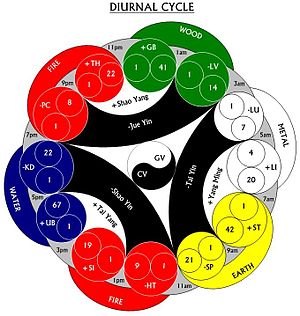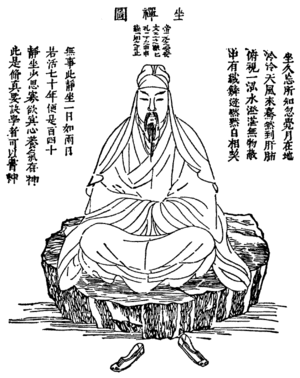 The Five Elements and the Diurnal Cycle
The Five Elements and the Diurnal CycleThere are specific qigong exercises, three that are mentioned here, that help bolster the energy of the lungs when they are deficient in qi. Disorders that are indicators of deficient lung qi include asthma, emphysema, bronchitis, and various causes of shortness of breath (dyspnea). Respiratory exercises are important to increase the flow and movement into the tissues of new qi, and to correspondingly allow the stagnant qi to leave.
Using the Five Element Theory to Help Heal the Lungs
According to the five element theory in medical qigong, when your lungs are deficient in qi, your overall energy is less because the lungs feed the kidneys with qi. In order to improve the lung qi, you need to nourish the qi in your
spleen and allow it to move to the lungs. One way of doing this is to visualize the color yellow and the sound "who" during inhaling. Take in the yellow-colored qi into the spleen (which is in front of the left kidney in the middle of the body). You can also visualize the elements associated with the spleen and lungs: earth and metal, respectively. Do this 9 or 18 times, and afterward, visualize the qi moving to both of your lungs while breathing normally and relaxed. Let it move and do not force it. Do this 2-3 times a day when you are challenged by any of the disorders mentioned above. Beginners should use 9 repetitions.
The color for the qi of the lungs is white and the sound is "Tzzzzzz." Breathe in the color white for the healing energy of this color, and on the exhale make the sound to allow the vibration to release toxic qi within the lung tissue. You may do this 9 or 18 times.
Either of the above exercises can be done lying down, sitting or in a standing wuji posture. When doing the sitting or standing posture, maintain an erect but supple spine and suspend the head from the neck, tilting it slightly down to open up the occipital area.
Finishing Standing Exercise for Tonifying and Clearing the Lung Channels
This exercise is done standing. Stand with the feet parallel and shoulder width apart and assume a relaxed wuji posture. Inhale and move the arms out to the side of the body and arch backwards slightly, inhaling the white qi. On the exhale, bend down (to your comfort level) and bring the arms down, swinging and crossing them back and forth while breathing out and making the lung sound. On the inhale, bring the hands up the legs and body, following the right extraordinary channel with the right hand (palm up), and the left channel with the left hand. When the hands reach the nipples, make a beak hand (all fingers and the thumb are connected) and extend the arms outward following the lung channel down the arm to the thumbs. When the arms are fully extended, open the beak hand with the palm upwards and thumb back, and exhale. Repeat the movement 9-18 times. For beginners, start with less repetitions.
Note: The
Taoist method of breathing (in qigong and tai chi) that is most common for healing is normal abdominal breathing. In this type of breathing, the diaphragm drops and allows the lungs to fill with new air. You will know if you are doing it right if your belly and sides of the body move outward when inhaling. On the exhale, the diaphragm relaxes and allows stagnant air to leave. Correspondingly, the belly contracts when exhaling. Also note that, in healing exercises, the inhalation is through the nose and exhalation is through the mouth and it is not forced. Inhale and exhale at only 70-80% of your capacity.












